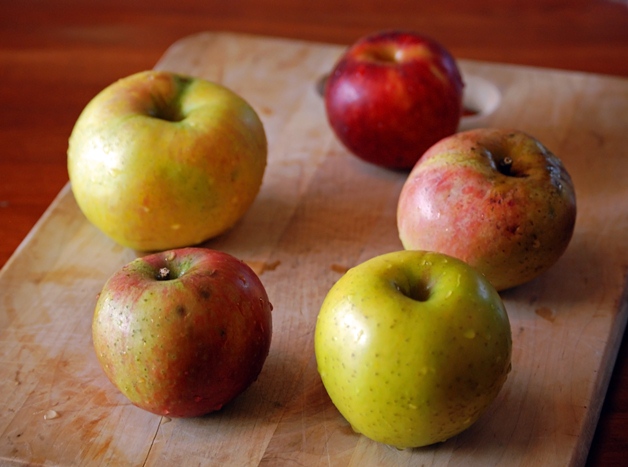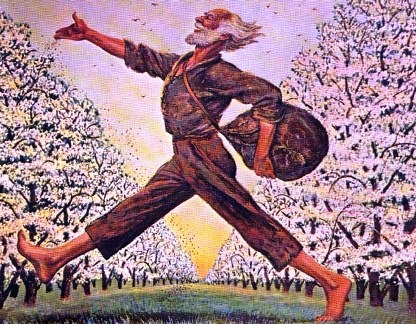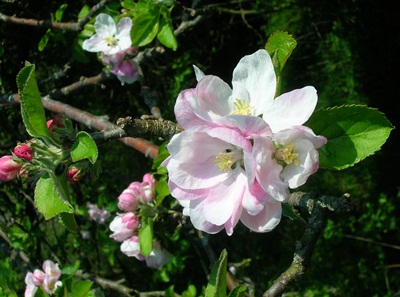I did something unusual and wonderful last Friday: I went to an apple tasting! This was the first time I had ever “tasted” apples with an eye to comparing the flavors of different varieties, and it was a fantastic, educational and fun experience.

We went for a visit to Moonfire Orchard in Northern Virginia which is run by a colleague of my husband. The orchard owners, Pat Hagen and his wife Jean, welcomed us into their home and chatted us up about apples and their plans for the orchard. They are growing only heirloom fruits and vegetables and carefully research each variety before adding young trees to the fields around their home. They have apples, cherries and blueberries as well as some heirloom vegetables – especially tomatoes and peppers – planted by custom order from local restaurants. We had hoped to get out and walk around the orchard, but the storms we have been having recently have left a thick layer of snow and ice on the property, so we confined our exploration of apples to an indoor tasting with apples grown on premises, but acquired from another orchard currently selling fruit.
The apples we tasted are pictured above with the Winesap at about twelve-o’clock, White Winter Pearmain to the right, Gold Rush next to that followed by Black Twig and Newtown Pippin closing the circle at around ten- or eleven-o’clock.
Pat told us that apples fall into basically three categories: eating, cooking and cider apples, and that there is a lot of overlap between these categories. Some apples work nicely in all three categories, some on the other hand are best for cider, but not for baking or eating.
We started with the Winesap. This apple originated New Jersey around 1800 and has given rise to many other famous apples including the Stayman, and Arkansas Black. It is a small to medium-sized apple that ranges from yellow streaked with red to the rich red of our Winesap in the picture. This is an apple that tastes like a grape. Its remarkable. As I bit into it, I immediately thought of the “Scuppernong” cider popular during colonial times that has been recreated at Colonial Williamsburg as a blend of apples and grapes. Pat explained that the Winesap is the base of many hard ciders because of its taste and juiciness. He also said that it was not the best apple for cooking and commonly lost its form when baked. Ahh but what applesauce!
Next up was the White Winter Pearmain which really does taste a bit like a pear. It has a confused history with some accounts saying that it has ancient roots in Europe beginning with the Romans around 12 ACE, some saying that it is an English apple dating to around 1200, and others saying that it is an American apple, originating around 1849. Whatever its history, this isn’t the prettiest apple you’ve ever seen as it is often covered with brown dots, but it does have a nice, almost sweet, complex flavor that is pearlike. It also is great for desserts.
The Gold Rush was next. Gold Rush is a modern apple that was created at Purdue University in the early 1990s from a Golden Delicious apple and an “experimental” apple. True to its name it has a powerful flavor that changes over time. It is very tart at harvest (early to mid-October), it mellows to excellence as a dessert apple after 6-8 weeks in storage. It is a good cider apple as well as a good cooking apple as well and it keeps its form nicely. A good all-round apple with a great (often tart) taste.

Saving the best for last, Pat laid the Newtown Pippin on us. This apple has an umami wow-factor to it that makes me wonder what the glutamic acid content of its flesh is. The flavor changes and increases as one chews it and you can feel distinct areas of the tongue being stimulated as you eat this fruit. It is said to have been George Washington’s favorite apple and originated in New York in the early 18th Century. Widely enjoyed during the colonial period they were brought to Europe in 1758 and caused a sensation there – with everyone wanting the fruit and saplings. The trees didn’t grow well in Europe and a lucrative trade in the apples began after the English apple crop failed in 1773. The fruit was exorbitantly expensive and went for four pence an apple at this time. The flavor is complex and delicious and develops as the fruit matures after picking and it also holds up well when cooked. Another great all-round apple.
After we tasted the apples, we had a slice of Jean’s delicious Black Twig apple pie and talked about the future of Moonfire Orchard. They are laying in another 100 trees in February and hope to begin selling their heirloom fruit in about three years. Some of the trees are already blooming, but they are pruned back to make the trees larger and more vigorous, even though doing this breaks Pat’s heart. They also want to get into cider production down the road as well.
I learned so much during the tasting that it is impossible to share it all in this space. I learned that there are apples cherished mostly for their aroma, called Strawberry Apples, such as the Strawberry Parfait and Chenango varieties, that were used as air fresheners in times past. I learned that Black Walnut trees planted upstream of an orchard will make it impossible to keep the apple trees alive and healthy, and I learned how a simple request for, “a couple of fruit trees,” in the garden can turn into a new life for two great people.
If you haven’t already done so, I recommend an exploration of heirloom fruits and vegetables. Bred for flavor, texture and aroma instead of appearance, they will make any dish better and possibly introduce you to some new favorites. (Words by Laura Kelley; Photo of Heirloom Apples for Tasting by Laura Kelley and Johnny Appleseed taken from a US Postcard ca. 1972, and Photo of Apple Blossom by Roger Griffith, Wikimedia)

